

|

Trail Marker about 1.5 miles from Old Mine, Done on side of road in 68 by persons unknown
The mine complex consists of a vertical shaft of undetermined depth, a small stone house structure, two square currals, a set of center currals, a low wall crossing the ravine and a rock on which some forgotten oldtimer had carved dates.
Obviously whoever built the mine had never seen a Hollywood movie or a television series. Rather than a horizontal shaft in the side of the mountains with the mandatory supporting pillars and crosspieces, this mine was a vertical pit in solid rock. A few stones thrown in told us it was much more than an overgrown badger hole.
For many years I had the impression that it was an oldtimer named Ross Conley that first took my Dad to the Mine. I guess this is because he was such a colorful fellow. In 1962 we went to see Ross before moving to Brazil, he had some relatively fresh venison being jerked on a fence. I remember my father saying something about it not being deer season and Ross kind of whispering to me that he had shot the animal with his shotgun in self defense and winking. He also has a full grown fully feathered owl in his freezer. Needless to say in the 30 or so years since then I have never encountered anybody else with an owl in the freezer.
However, I was recently informed by a more knowledgeable person - my Father himself - that it was Jack Burkett who showed him the mine. Jack ran the general merchandise store in Maricopa in the 30s, and reportedly heard of the mine from some of the Indians who would come in, do their buying and sit and tell stories.
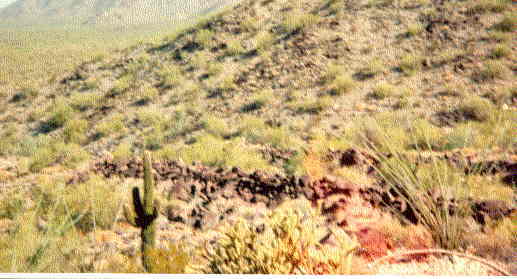
Square currals on side of hill. More extensive round currals are found below in middle of ravine, but overgrown.
To answer these questions I decided to some research, some of which has provided the material in this article. After visiting a few libraries, I soon found that this 20 (?) mile mountain range directly southwest of Phoenix is practically unknown, unchronicled and unvisited. Although they can easily been seen from almost anywhere in the Valley of the Sun, a search for information on them in public libraries yield one or two index cards and many a blank computer screen.
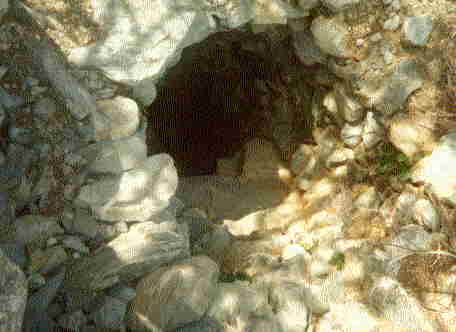
The well, most filled now by 300 years (?) of sand deposits from canyon wash
Although there is a strong tradition in Arizona of extensive mining activities supposeitively conducted by early Spanish priests, particularly popular in the in the multitudes of treasure books weighing down library shelves, there is no real proof to support this fantasy. There are however several references to general mining activities in the chronicles of the priest and expedition leaders, especially during the times of Padre Garces. I found no specific mention of Spanish era mines or mining activities closer than the Gila Bend and Ajo areas. A search through some of the many "Do It Yourself Find A Lost Mine" books did mentioned several mines and buried treasures in the Sierra Estrellas, however my own personal knowledge of the area and common sense told me these were both inaccurate and nonsense, and had nothing to do with my mine.
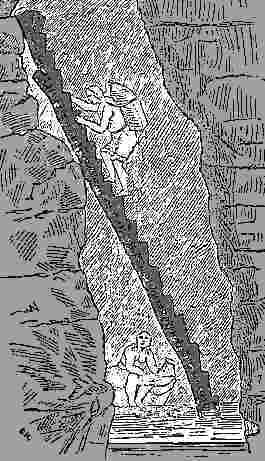
Old engraving, showing primitive mining in the Southwest. The Indians get to do the rough work
Although Kino makes a brief mentions mining activities in his writings, it was Manje that first brought up the mining question in what is now Arizona. Manje had often traveled with Kino and presents in his journals a secular viewpoint to the discoveries and development of the new territories, as opposed to the spiritual concerns of the Jesuits. In 1706 Manje, who was both an administrative official and a military officer, wrote an account of his travels in the "Unknown Lands" and sent it to the Viceroy in Mexico City. For the most part his writings and experiences parallel and complement those of other explorers. However somewhere in the Southwest he must have been stricken with the first recorded case of politicis infermas - the dreaded disease that seems to afflict politicians in Cinerea and Arizona. Must be something in the air. Anyway, as told by historian H. Bolton, Manje included a final chapter in his book giving some unwelcome opinions on mission matters. Among other things, he declared that the missions were keeping most of the wealth to themselves and leaving only unsuitable land for the Spanish settlers. He also suggested that Indians be assigned to work in the mines, since, quoting Bolton's translation "in this province there are no slaves ... to work the mines unless it be Indians." Certainly it was not by coincidence, the royal decree granting twenty years of protection for the Indians against forced labor was about to expire. Manje's ideas were just one more drop - one of the first however - in the bucket of accusations in the growing conflict between Spanish civil authorities and settlers against the Jesuits, that would culminate with the expulsion of that order in 1676. Although his writings caused a first class uproar - and landed him in jail - eventually all parties were able to smooth things over - well, sort of. Although officially reputed at that time, Manje's proposals become a de facto plan of action that would adequately describe the relationships between white and Indian, and Spanish civil and religious goals.

John R. at the Old Stone House, in 1994. Probably the third oldest house in Arizona, 200 years older than Mike Monti's La Casa Vieja in Tempe, just a few dozen miles away. ... And unknown Why am I writing about an obscure 18th century document? Because Jack Burkett told my father that he had learned of the mines from Indians, who told him stories of their ancestors being enslaved to work there. Another important factor to be considered is that the Jesuits were expelled from the New World in 1767, and the royal decree excluding the use of indians as slave labor had been revoked - in practice if not in theory - by the early 1700s. In 1736, near Nogales on the US - Mexican border, rich silver deposits known as the planchas de plata, or planks of silver, were discovered at as site usually called Arizonac, giving us one of the many possible theories on the origin of the name of our state and causing an explosion of mining activity all along the northern provinces of Mexico.
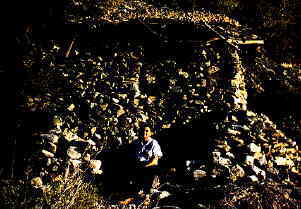
Dad in front of house , around 1955. Notice the roof made of Ocatillo branches
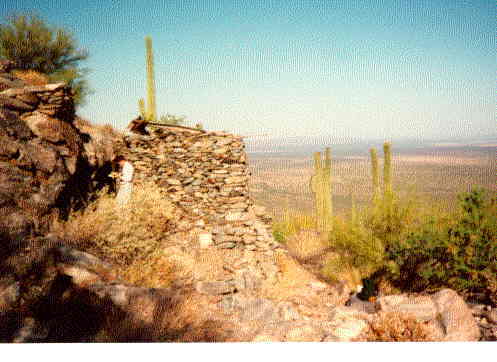
Stone House, side view. Arthur reading messages in bottle left by previous visitors
Because Spanish law required the registration of all claims and mining activities, so that the crown could receive the royal quinto - a fifth of the mineral recovered (It was actually a sliding scale system) due to the King. The 1584 mining ordinances were detailed and set definite requirements for claims to be recognized by the Crown. One requirement was that a shaft about 19 feet be dug within three months and deepened by the same amount by the end of six months. Because the ordinances also required that detail reports be submitted to the Viceroy, it may be possible to find a precise record of the mine and its activities in the archives in either Madrid or Mexico City. An alternative could probably be attempted through an archaeological dig.
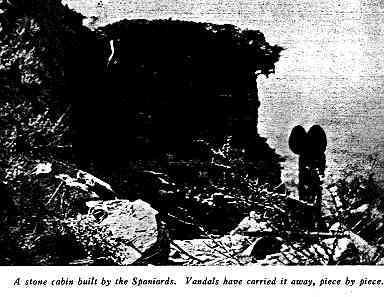 from same angle as above, Stone House as seen in 1935 Arizona Highways Magazine, one of the very few times Old Mine was in Mainstream Media
from same angle as above, Stone House as seen in 1935 Arizona Highways Magazine, one of the very few times Old Mine was in Mainstream Media
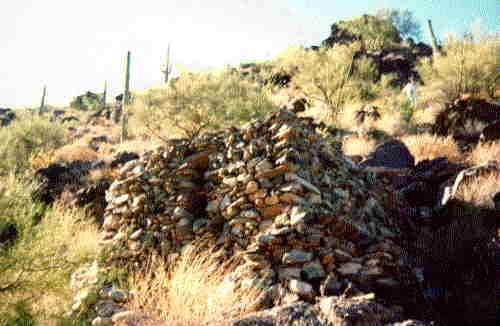
The Stone House, from below.
There are other stories of of buried mines and lost treasures in the Estrellas, but Mitchell's is a clear step above the others in facts and historical basis. Let me say that it is impossible that the Old Spanish mine could have produced significant amounts of mineral weath. Maybe $3 or $3000, but not $3,000,000
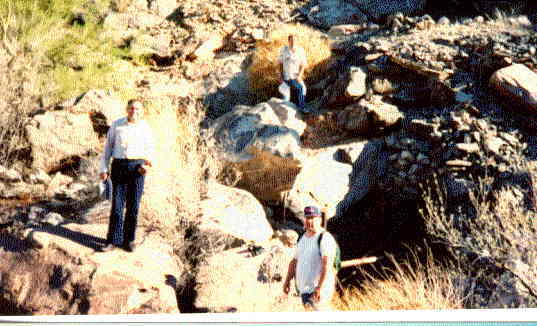
Front to back: Jim, Paul, Yours Truely around Mine Shaft"
After much thought on the matter, I feel that circumstantial evidence leads to the conclusion that the mine is really as old as the dates on the rock indicate. The 1720 and 1740 dates fit the time window in which the events were most favorable for the mine to have been dug. In fact, the first half of the eighteenth century has been called the golden years for the Spanish. It was a time of relative peace with the indians and exploration was intensive in all the Southwest. It can hardy be less than ninety years old because my family and friends have know of it for most of this century. The stone cabin construction does not seam to be what an American miner or prospector would have built. The vertical pit shaft appears to be the of the same type as that shown in the xxxxx, illustrating a typical spanish mine. I found no sign of explosives being used, as would be expected in the case of an American era enterprise.
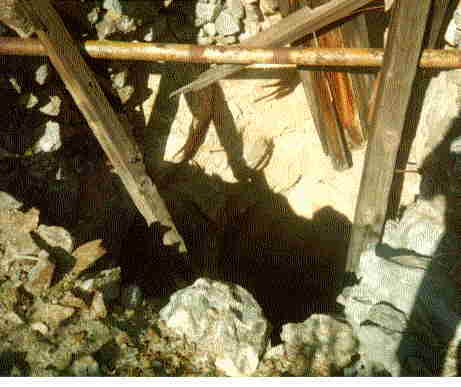
Close up of shaft showing work done in 60s and 70s (?)
If the little stone house was built early in the 18th century, then it is probably the third oldest standing structure built by the Spanish in Arizona, after the missions at Tumacacori, in a state of ruins, and San Xavier del Bac, still standing magnificently. That would probably make the little house probably the oldest non-religious building surviving from that era - and within a few miles of Phoenix. Is it possible? Only in the Sierra Estrellas.
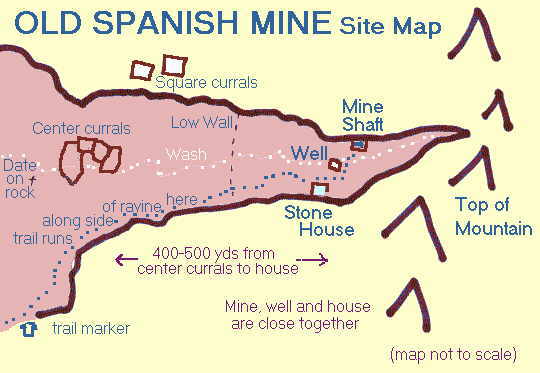
General map of mine area
For more information on the Sierra Estrellas check out these pages here:
The Story of the Estrellas
Maricopa Wells and the stage route
Old Charts of Region
The Old Spanish Mine
Map of the Estrella Mountains
The Patio - the most historic area of Estrellas